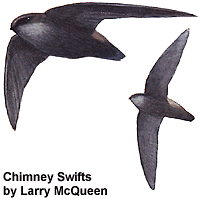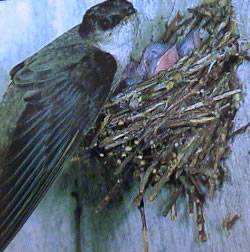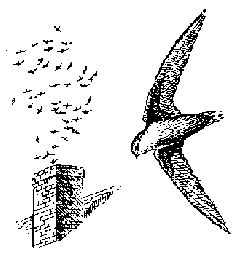Common Birds
Chimney Swift
One of our most fascinating summer birds is the Chimney Swift. Commonly referred to as a flying cigar with its elongated body and long wings, these swifts have been clocked at speeds of 150 miles per hour in pursuit of catching insects on the wing. 
Chimney Swifts are long distance Neo-tropical migrants which winter in eastern Peru. This annual trip between North and South America covers more than 6,000 miles round trip. Although there are several swift species in the United States, the Chimney Swift is the most common and widely distributed. They occur from the Central Great Plaines to the Atlantic Coast, and from the eastern portion of Canada to the Gulf of Mexico. They arrive for the summer months beginning in early March, spreading north through May and April. These swifts will begin to form communal flocks by the end of August, usually leaving in large groups by Mid-September in the upper ranges of their territory and by November have completely vacated the continent. If you pay attention to these flocks congregating in late summer, early fall, it is a very eerie feeling when one morning you walk outside and the sky has fallen suddenly silent upon their night time departure.
Chimney Swifts are easily recognized. When flying they appear to have a cigar shaped body about 5 ½ inches in length, with long pointed crescent shaped wings that span 12 ½ inches. The plumage of the male and female are similar as is that of the juvenile birds. They have a dark gray brown upper body which is paler on the throat, chest, and under wings. The only distinguishable features of the sub-adults are their slightly shorter wings. They are constantly in flight alternating between very rapid wing beats, then a gliding motion with rigid wings held out. While in flight they make a continual chattering and twittering vocalizations.
Very few people ever have the opportunity to see them at rest since Chimney Swifts are incapable of perching on a branch or ledge as other birds. In fact these swifts are so specialized and adapted to clinging to vertical surfaces that they cannot perch or even stand on their extremely short legs. Their tiny feet have four hook shaped toes they use to hold on to rough vertical surfaces. Further support is provided by the stiff tail feathers which have ¼ inch exposed spiny tips. These adaptations have allowed swifts, who traditionally used hollow trees, to use chimneys.
Chimney Swifts actively nest from May through July. But with the loss of many giant hollow trees that were cleared for agriculture and development over the previous two centuries, these birds became quite comfortable in urbanized areas where numerous open chimneys built with stone and mortared brick were almost exact replicas of the original trees used for nesting.
 Their nest is made of twigs glued together and onto the wall of the chimney with their saliva. The cup shaped nests are located deep enough down the chimney to provide shade from the hot sun and protection against summer rains. The female will lay three to seven white eggs, which she will cover at night. Once the clutch is complete incubation begins. The eggs will hatch in 19-20 days but it will take another 30 days before the young are ready to leave the nest. Chimney swifts can nest more than once in a season if a nest is destroyed.
Their nest is made of twigs glued together and onto the wall of the chimney with their saliva. The cup shaped nests are located deep enough down the chimney to provide shade from the hot sun and protection against summer rains. The female will lay three to seven white eggs, which she will cover at night. Once the clutch is complete incubation begins. The eggs will hatch in 19-20 days but it will take another 30 days before the young are ready to leave the nest. Chimney swifts can nest more than once in a season if a nest is destroyed.
During the nesting phase of Chimney Swifts there will almost always be a single breeding pair to a chimney. The brooding and raising of young is between June and August. If you’re lucky enough to have a pair nesting in your chimney you may be able to hear the young birds. They are loudest when being fed by their parents. However, by the time they are loud enough for you to hear them, they are almost old enough to feed themselves. Shortly after that the loud noise will cease.

The sound of young Chimney Swifts wafting from the fireplace may not be appealing to everyone. But consider this: Chimney Swifts are extremely beneficial. One pair of adults and their noisy young will consume over 12,000 flying insect pests every day. Since their beak is very small the insects they prey on most are mosquitoes, gnats, termites and biting flies. These birds live on the wing and have been clocked at speeds approaching 150 MPH foraging for insects while in flight. They will commonly feed in groups from half a dozen to several dozen, flying closely together and making a high-pitched chipping noise. Imagine how many insects several dozen swifts can consume in a day.
By August, with the nesting season over, Chimney Swifts will begin to congregate in large numbers, sometimes up to a hundred or more. As this massing in numbers begins to occur they will use a single chimney as a roost. After a day of foraging for insects on the wing, they will return to this communal roost in the evening. Swarming in large numbers above the chimney at dusk they will, as if in a choreographed maneuver, dive into the vertical shaft in groups at a high rate of speed. The following morning they can be seen leaving the roost as if being shot out.
In past years the population of Chimney Swifts may have increased over historical numbers with the introduction of large masonry chimneys that provided nesting sites. But with suitable man-made habitat becoming less common, their numbers are declining in some areas. According to a recent Audubon analysis compiled from the Breeding Bird Survey data, Chimney Swift numbers have declined by 48 percent in the last 40 years, This is likely the result of many houses being constructed today without chimneys, or chimneys that are constructed using smaller metal flues rather than clay liners. These metal flues can sometimes be death traps for swifts. The population of Chimney Swifts may also be declining due to the practice of capping or closing chimneys altogether that were once used by these valuable birds reducing nesting sites even further. In fact with suitable man-made habitat becoming less common, their numbers continue to decline. They were listed as a threatened species for several years and could likely become listed under the Species at Risk Act.
There is some good news for Chimney Swifts, however. The North American Chimney Swift Nest Site Research Project (NSRP), administered by the Driftwood Wildlife Association, has designed and tested alternate nesting structures for swifts. The most elaborate and successful of these is an artificial chimney, 12 to 20 feet high and 2×2 feet in dimension. Several Audubon chapters and other groups have started placing swift towers in local parks–sometimes surrounded by a small native plant demo garden. These towers provide habitat for the birds, as well as public information and visibility for the chapter. Some homeowners are constructing more simple designed artificial swift towers in their backyards in an effort to provide Chimney Swift nesting sites.
Fun Facts About Chimney Swifts
• Chimney Swifts traditionally nested in cave and hollow trees before the settlement of North America. However, they greatly benefited from the construction of chimneys which increased available nesting sites. With less chimneys constructed with new homes, the use of metal flues, and capping or plugging of existing masonry chimneys is a factor in their declining population. For information on creating a Chimney Swift tower made specifically for nesting swifts go to the North American Chimney Swift Nest Site Research Project. or www.ChimneySwifts.org.
• Chimney Swifts are unable to perch like other birds or walk on the ground, but use hooks on their tiny claws and spiked tips on their tails to cling to vertical surfaces.
• Chimney Swifts must fly constantly when not at the nest or roosting at night. They must do everything while in flight from catching flying insects; collect nesting material which includes breaking twigs off trees, and drinking. To bathe, swifts will slap the surface of water collecting the droplets and shaking the water from its plumage as they fly.
• Chimney Swifts do not nest in colonies, but large numbers will roost together during the non-breeding season. Although there will only be one pair of nesting swifts in a chimney, they occasionally allow other none nesting swifts to roost.
• Chimney Swifts consume large quantities of insects every day. In fact it can be as much as three times their own weight. Many of the insects they consume are considered pests.
• The nests of Chimney Swifts are constructed mainly of small sticks. These sticks are glued together, and secured to the vertical wall of a chimney with their saliva
• Often, if a Chimney Swift ends up on the ground, it becomes difficult for them to become airborne again due to their short feet and long wings. If you find a swift on the ground and they do not appeared injured, a gentle toss into the air will put them back in flight.
